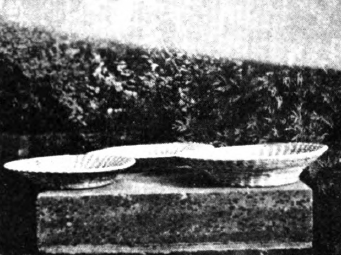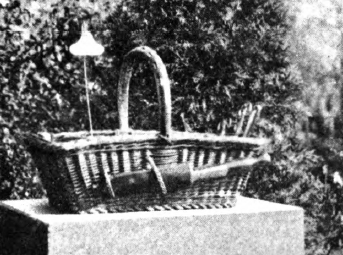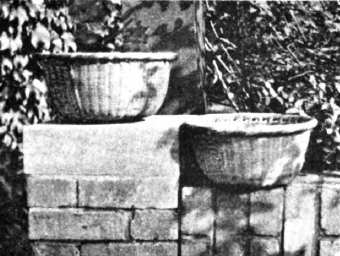| Web
and Book design,
Copyright, Kellscraft Studio 1999-2016 (Return to Web Text-ures) |
 (HOME)
|
|
"As midsummer approaches
the energies of the gardener
must be directed towards keeping the garden at a high level of
excellence, and
this can only be done by unceasing care and attention." — "Saturday in my Garden," FARTHING. GARDENING EXPEDIENTS When sudden clouds darken
a hot June
sky, the gardener and I, taking plenty of twine or raffia, hurriedly
tie into
sheaves the taller and more delicate flower-stems such as delphiniums,
Canterbury bells, pyrethrums, physostegias, and taller phloxes, and
other
especially precious things. Taller or shorter stakes are hastily driven
in, and
this support and close tying has saved for us many a raceme and panicle
of
later bloom. I commend this plan as excellent, particularly if one's
Garden
Club is expected on the following day and the hostess's heart sickens
before
the possible devastation by wind and rain. Flower cutting is a
subject by
itself and one not frankly enough discussed. It may be — it constantly
is — done
wastefully, and there is not among us a true gardener who would
willingly waste
a flower. It may be done too sparingly, and, to my thinking, sparing
the garden
shears spoils the garden more quickly than the proverbial rod the
child. After
years of cutting, certain habits become instinctive, and these I will
give as
numbered suggestions. First: If your cutting is
done in a
formal garden, give a comprehensive look at the whole before taking up
your
basket and shears. If it is a question of which matters more to you,
your house
or your garden, always consider the garden. Notice where flowers are
spindling
up, where a ragged spot exists, where bloom is so luxuriant as to
injure the
effect, where the blessed requirements of balance should be looked
after. In
the case of overluxuriance of bloom, a constant happening, the plant
which is
advertised as being "covered with flowers" is considered by
discriminating
gardeners as either a monstrosity or a curiosity. I have no doubt that
a
painter of gardens such as Mr. George Elgood insists upon cutting away
a bit
here, a mass of color there, before placing his easel in final position
for the
painting of the delicious garden pictures for which he is renowned.
Wealth of
bloom! When shall we learn that this is a phrase which seldom or never
leads to
beauty P Not in quantity dwell the best joys of gardening! The
advantage in the
idea of too many flowers lies in the fact that here we have material
for
picture-making by skilled and judicious cutting. Who does not love to
so
attenuate the rambler rose over the good gateway by taking out here and
there a
cane, as to leave it a characteristic climbing one, throwing its lovely
garlands lightly over their support and permitting all the beauties of
stem,
thorn, leaf, and flower to be clearly seen and gratefully enjoyed?
And now for brief mention
of a minor
convenience of mine for recording spring or fall orders of plants or
bulbs.
Taking a strip of heavy manila paper twenty-four inches long and four
deep, I
fold it to open after the manner of those small books of so-called
"views" which one can buy at any watering-place here or abroad,
making a crease at every two and three-quarters inches, which secures
eight
pages at once. On each of these pages I paste a sheet of writing-paper
torn
from a small block of about the size of the page. The book then, with
the
addition of a gummed label for title affixed to outside of upper cover,
is
ready for use. The advantage of such a trifle is that by taking each
end of the
little note-book at once and moving the hands in opposite directions,
the whole
inner surface of notes lies open at once before one. Each spring and
fall I
make a fresh book of this type. I find it an immeasurable help where
time is
precious. Now my bills or invoices may be left indoors instead of
proving
fluttering anxieties in the garden! Of the little
kneeling-mat I use, I
would like to say one word. It is an oblong mat, dark crimson in color,
and is
made of nothing more nor less than two thicknesses of woollen-plush
covering
from an old "Shaker" chair. This mat might in one way be better. Its
color might be a bit brighter, so that the small convenience should be
more
easily discernible on the grass before a border, or between the beds of
a
garden. I would suggest a bright blue or a yellow. Aside from this, the
little
arrangement is very perfect for its purpose. Soft, thick, and light, it
is the
faithful companion for all seasons when planting, transplanting, or
cultivating
is the order of the day. For carrying flowers, if
baskets
happen to be less conveniently at hand than usual, or where it might
prove a
burden to the flower-recipient to have to return baskets, I often cut
double
sheets of heavy wrapping-paper into a roughly graceful shape of some
picturesque arching basket which is in my memory, leaving two strips at
top for
handle. These strips are fastened together by pins at their ends, the
sides of
the papers are joined in the same manner, and the whole pressed gently
open
from within, when a practical and satisfactory receptacle is created
for
holding and keeping cool the stems. Frosts, with us, are due
in early
September. Heliotropes are apt to blacken then, Japanese anemones to
receive
that baptism of cold from which they do not recover. To offset such
diminishings of the garden's color, I keep hidden away back of some
white
spruces a number of pots of the good geranium Mrs. E. G. Hill, whose
color,
according to Ridgway, is appropriately enough geranium pink. These,
when set
among the foliage of plants which have done their duty by the garden,
give a
look of gayety at once, and help enormously to prolong the feeling of
summer
which with each day becomes more dear. Miss Jekyll it surely was who
first
suggested this expedient, but I cannot at the moment give chapter and
verse. Not long ago a delightful
defense of
the geranium appeared in "The Point of View" in "Scribner's
Magazine": "The truth of the matter is, we can none of us get along
without the geranium. Or, if we do, we all of us suffer the
consequences of
great empty crying holes in our flower-beds. We all know how it is.
During May
and June and part of July our gardens exult in crowded ranks of glory
upon
glory. Most of our temperamental flowers catch enthusiasm from one
another and
have their fling all together. The result is intoxicating while it
lasts, but
it is followed by a disheartening midsummer slump. Suddenly the mood
changes,
the petals fall, and the color and the fragrance are gone. As dull and
sober as
they were erewhile brilliant and animated, our irises, peonies, roses,
foxgloves, larkspurs, rockets, present a monotonous sequence of barren
green
leaves to our disappointed eyes. The hopeful annuals are not yet more
than in
dubious promise; the phlox and dahlias have hardly set their buds. The
whole
garden suffers eclipse. "This is precisely the
geranium's opportunity, and we are as cruel as we are stupid if we deny
it to
her. She would only fain prevent an entire collapse and would gently
keep the
garden's head above water until such time as it feels like swimming
again. She
can do this as no one else can, blooming brightly and quietly here and
there
among the discouraged plants, keeping up general appearances, saving
the
gardener's self-respect when passing wayfarers pause to look over his
fence in
quest of the color which they have come to expect of him." Where shall we look for a
stock of
geraniums from which to choose our colors and our types? No farther
than to
Maryland, where from White Marsh Mr. Richard Vincent sends forth a list
of
hundreds of beautiful examples, single and double, ivy-leaved, plants
with
variegated foliage, seventeen varieties of scented-leaved, one
so-called Regal
pelargonium, and nine cactus-flowering geraniums. All this is a most
sumptuous
illustrated list, a perfect treasure-house for those who plan gay color
for
their borders. On page 8 of this list is not only a geranium shown of
loveliest
delicate pink, Berthe de Presilly by name, but immediately below this
picture
is another with a really most happy use of geranium and sweet alyssum
together.
I do not stand for the copious use of Scarlet Bedder, no, not at all;
but who
could not find a spot where Alpha with its lovely small blooms, not
unlike a
scarlet lychnis, might not be useful, or, near cream-white stock, Baron
Grubbisch or Rosalda might not create a picture? In the geranium lies
an almost
untouched field of beautiful and practical resource for gardens. I am
perhaps
not too rash in saying that I believe most of us have not seen over ten
varieties of this flower. We bring to any consideration of it a
preconceived
idea of ugly misuse. Why not devote a small portion of ground another
season to
trials of the geranium for uses of our own devising? If, therefore, the
geranium, being a
garden standby and a garden adornment, may be called a garden
expedient, as
indeed it may, one other faithful flower may aspire to the like honor.
The
zinnia has during these last years of gardening furor come into its
own. Among
all the charming things for garden and for house it holds high place.
If one
buys, as has before been hinted, packets of seed of white and
flesh-color only,
almost all the softer tones of creamy white and pink, with often
wonderfully
arresting hues hardly describable, are forthcoming. A flower of
splendid form
and substance, a flower of great rigidity of stem, a flower of generous
freedom
of bloom, a flower of the most fascinating decorative possibilities,
where
would my garden — my September garden — be without the zinnia! As for other planting
expedients, to
my thinking, none are better than that of alternate planting in the
row. This,
of course, is for formal effect. Two periods of bloom are so easily
thus
secured in practically the same spot. My first experiment in this
matter was
with Michaelmas daisies, early and late, as has been told in a former
chapter;
my next was with a close-set row of pentstemon barbatus coccineus and
hardy
phlox; the latest and most ambitious was with a border of spring
flowers
arranged with the idea of securing much bloom and some beauty in a
small given
place. This, too, is fully described elsewhere. A note in a recent
number of
"The Garden Magazine" seemed to me full of practical possibilities.
It concerned a system of "planting-cards," and I will tell of these
in the contributor's own words: "I cut cards of strong
white
pasteboard, measuring eight by twelve inches, and in the middle of the
narrow
side of these I put a loop of string for hanging. The back of the card
is left
blank so that garden notes and memoranda may be written there, and on
the face
of the card I paste the names of the vegetables to be planted and their
cultural directions. These I obtain from the catalogues of the seedsman
from
whom I order my seeds. For example, with ' Corn' I paste first their
cultural
directions, then under this the names and descriptions of the four
varieties I
intend planting, in the order of their earliness and lateness. By each
variety
I make a note in ink of the quantity of seed ordered and another note,
`Plant
every two weeks till July 15.' This is done for each kind of vegetable
and
toward the right I leave a margin of one and one-half inches on which
to note
the dates of sowings. These cards will not take the place of garden
note-books or
of systematic garden records, but have the advantage of costing nothing
and of
being ever ready." The writer prefaces this
description
of what seems a really useful, if slight, gardening expedient by the
remark
that such cards save much time and trouble of a fine spring morning.
They are
ready to hand to a man who does garden work, and form an excellent
reminder for
oneself besides. I cannot see why such a little card arrangement might
not be
equally good for the recording of notes of flower-seed sowing as well
as for
that of seeds of vegetables. |
|||||||





